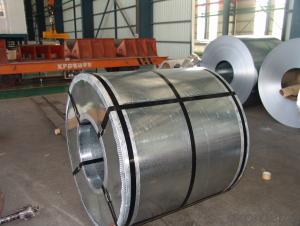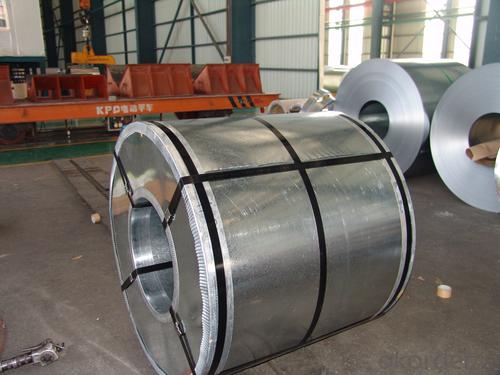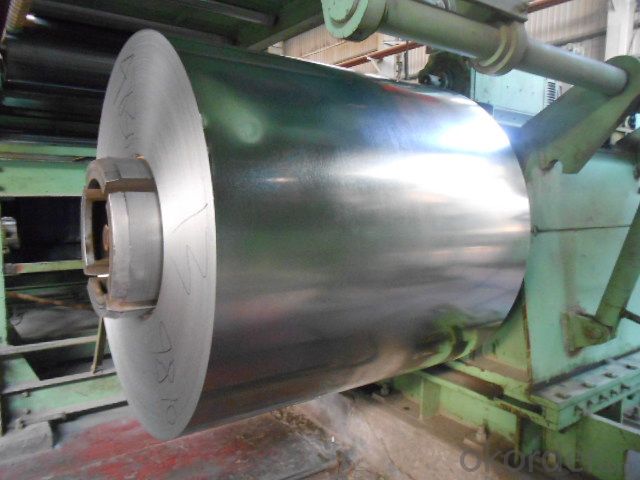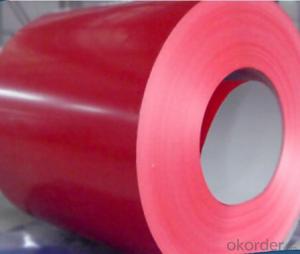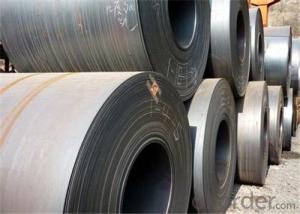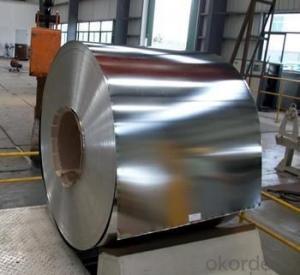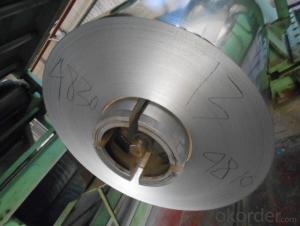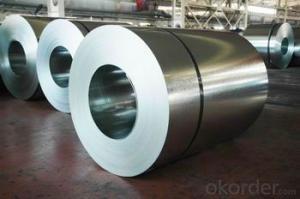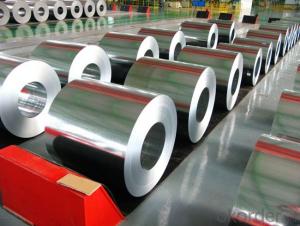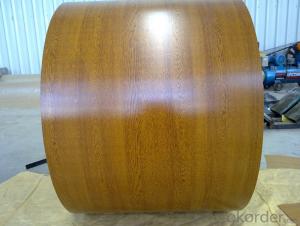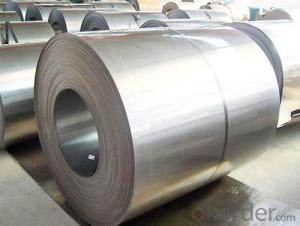Hot Dip Galvanized Steel Coil in Best Quality
- Loading Port:
- Tianjin
- Payment Terms:
- TT OR LC
- Min Order Qty:
- 50 m.t.
- Supply Capability:
- 10000 m.t./month
OKorder Service Pledge
OKorder Financial Service
You Might Also Like
Hot-dip Zinc Coating Steel Building Roof Walls
1.Structure of Hot-Dip Galvanized Steel Sheet Description:
Hot-dip galvanized steel coils are available with a pure zinc coating through the hot-dip galvanizing process. It offers the economy, strength and formability of steel combined with the corrosion resistance of zinc. The hot-dip process is the process by which steel gets coated in layers of zinc to protect against rust. It is especially useful for countless outdoor and industrial applications. Production of cold formed corrugated sheets and profiles for roofing, cladding, decking, tiles, sandwich walls, rainwater protective systems, air conditioning duct as well as electrical appliances and engineering.
2.Main Features of the Hot-Dip Galvanized Steel Sheet:
• Excellent process capability
• Smooth and flat surface
• Workability, durability
• Excellent anticorrosive property
• High strength
• Good formability
• Good visual effect
3.Hot-Dip Galvanized Steel Sheet Images
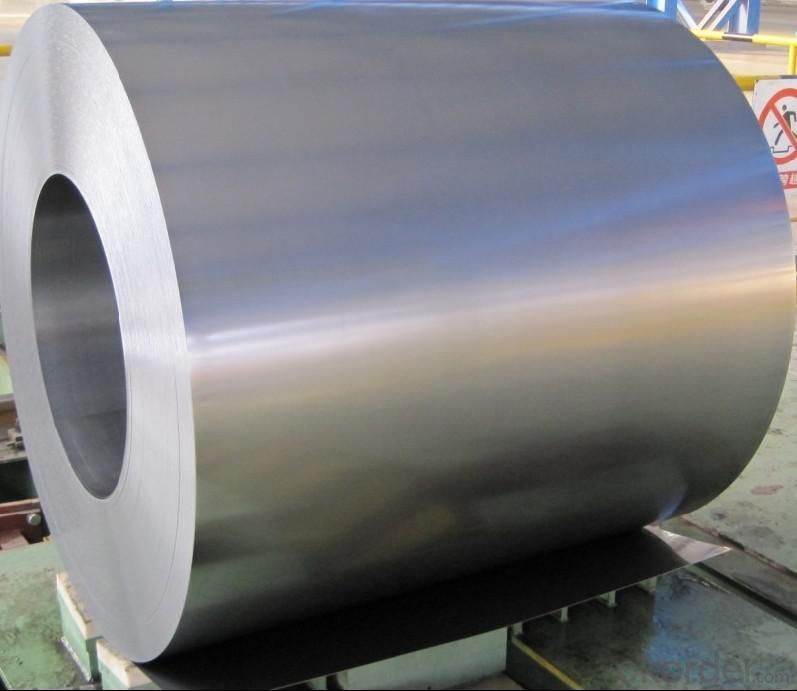
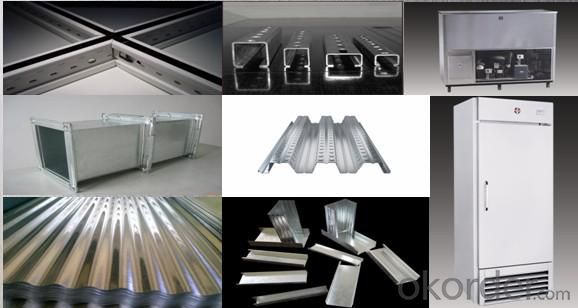
4.Hot-Dip Galvanized Steel Sheet Specification
Standard: ASTM, JIS,EN
Grade: CS, DX51D+Z,SGCC, SS 230~550,S220GD+Z~S550GD+Z, SGC340~SGC570
Thickness: 0.1mm~5mm
Width: max 2000mm
Coil weight:3-12 MT
Coil ID:508/610mm
Surface structure: zero spangle, regular spangle or minimum spangle
Surface treatment: Chromate treatment, Oiled/dry, skinpassed/non-skinpassed
Packing: Standard seaworthy export package
Technology test results:

5.FAQ of Hot-Dip Galvanized Steel Sheet
We have organized several common questions for our clients,may help you sincerely:
1.How about your company?
A world class manufacturer & supplier of castings forging in carbon steel and alloy steel,is one of the large-scale professional investment casting production bases in China,consisting of both casting foundry forging and machining factory. Annually more than 8000 tons Precision casting and forging parts are exported to markets in Europe,America and Japan. OEM casting and forging service available according to customer’s requirements.
2.How to guarantee the quality of the products?
We have established the international advanced quality management system,every link from raw material to final product we have strict quality test;We resolutely put an end to unqualified products flowing into the market. At the same time, we will provide necessary follow-up service assurance.
3. How long can we receive the product after purchase?
Usually within thirty working days after receiving buyer’s advance payment or LC. We will arrange the factory manufacturing as soon as possible. The cargo readiness usually takes 15-30 days, but the shipment will depend on the vessel situation.
- Q: im buying a new guitar,, it has a built in tuner and its semi acoustic (can be plugged into an amplifier) ,, im trying to choose which strings are better ,, steel or nylon..?
- i have steel and i like the way it sounds but i like nylon better
- Q: How are steel coils coated or painted?
- Steel coils are coated or painted through a process called coil coating, which involves cleaning the surface, applying a primer, and then adding a topcoat using various techniques such as roll coating, spray coating, or electrostatic coating. This ensures that the steel coils have a protective layer and an aesthetically pleasing finish.
- Q: How are steel coils coated for added protection?
- To enhance their durability and resistance to corrosion, steel coils undergo a process known as coil coating, wherein a protective layer is applied onto their surfaces. There are several methods employed to coat steel coils, but the most commonly used one is the continuous coil coating process. Under this process, the steel coil is unwound and extensively cleansed to eliminate any contaminants or impurities on its surface. This step ensures proper adhesion of the coating material. Once the steel coil is cleansed, it undergoes a pre-treatment to enhance its surface properties. Typically, this involves the application of a chemical solution or a conversion coating onto the coil's surface. The aim of this step is to create a surface that is receptive to the coating material and improves its adhesion. Following the pre-treatment, the steel coil is coated with a protective layer, which can be in the form of liquid paint, powder coating, or a combination of both. The coating material is applied evenly onto the coil's surface using techniques like roll coating, spray coating, or electrostatic coating. Once the coating is applied, the steel coil is cured or dried using heat or, in some cases, ultraviolet light. This curing process ensures a strong bond between the coating material and the steel surface, resulting in the desired protective properties. The coated steel coil then undergoes inspection to ensure quality control measures like thickness, adhesion, and appearance are met. If the specifications are satisfied, further processing may take place, involving cutting, slitting, or forming the coil into the desired shape or size. In conclusion, the process of coating steel coils for added protection involves thorough cleansing, pre-treatment, application of a protective coating, curing, and quality control. This ensures that the steel coils exhibit excellent resistance to corrosion, abrasion, and other environmental factors, making them suitable for a wide range of applications across various industries.
- Q: How do steel coil manufacturers handle product recalls?
- Steel coil manufacturers handle product recalls by following a systematic process to ensure the safety and satisfaction of their customers. Here is an outline of the steps involved in handling product recalls: 1. Identification of the issue: Once a potential problem or defect is discovered in the steel coils, manufacturers initiate the recall process. This may be due to a quality control failure, safety concern, or non-compliance with industry standards. 2. Investigation and evaluation: The manufacturer investigates the root cause of the problem and evaluates the potential impact on customer safety and satisfaction. They analyze the affected batch or production run to determine the extent of the issue. 3. Notification: Manufacturers promptly notify customers who have purchased the affected steel coils. They use various channels, such as direct mail, email, phone calls, or public announcements, to inform customers about the recall. The notification includes specific details about the problem, potential risks, and instructions on how to proceed. 4. Retrieval and replacement: The manufacturer provides instructions on how customers can return or dispose of the recalled steel coils safely. They may offer options for product retrieval, such as direct pick-up from the customer's location or designated drop-off points. In some cases, manufacturers may provide replacement steel coils or reimburse customers for the affected products. 5. Public communication: Steel coil manufacturers issue public statements and notifications to inform the wider market, distributors, and retailers about the recall. This ensures that all stakeholders are aware of the issue and can take appropriate actions to address it. 6. Corrective actions: After retrieving the recalled steel coils, manufacturers implement corrective actions to rectify the issue. This may involve improving their quality control processes, upgrading manufacturing equipment, or revising product specifications to prevent future recalls. 7. Customer support: Throughout the recall process, manufacturers provide customer support to address any concerns, questions, or complaints. They establish dedicated hotlines, email addresses, or online portals to assist customers with their inquiries and guide them through the recall process. 8. Regulatory compliance: Steel coil manufacturers ensure compliance with relevant regulatory authorities and standards organizations during the recall process. They work closely with regulatory agencies to provide necessary information, documentation, and updates to address any legal requirements. Overall, steel coil manufacturers prioritize customer safety and satisfaction when handling product recalls. They follow a well-defined process that involves identification, investigation, notification, retrieval, replacement, public communication, corrective actions, customer support, and regulatory compliance. Through these steps, manufacturers aim to rectify the issue, prevent harm, and maintain trust with their customers.
- Q: How are steel coils used in the production of automotive exhaust systems?
- Steel coils are typically used in the production of automotive exhaust systems as they provide the necessary material for manufacturing exhaust pipes and components. The coils are often processed and shaped into the desired forms, such as tubes or mufflers, and then welded or fastened together to create the exhaust system. Steel coils are favored due to their durability, heat resistance, and ability to withstand the harsh conditions of exhaust gases, ensuring the longevity and efficiency of the automotive exhaust system.
- Q: I want to buy a machete made of 1055 carbon steel, and want to know if this steel is durable for repeated use, or even combat use.
- 1055 Steel
- Q: How are steel coils used in the manufacturing of braking systems?
- Steel coils are used in the manufacturing of braking systems to create brake pads and other components that require heat resistance and durability. The steel coils are shaped and processed to form brake pads, which provide friction against the rotor to slow down or stop the vehicle. Additionally, steel coils are also used in the production of brake calipers, rotors, and other parts that ensure efficient and reliable braking performance.
- Q: i want a good modern carbon steel (not stainless) knife. trying to keep it under 50$ also nothing to gruesome just a small pocket knife. thank you
- Well, okorder /... They did make other folders in M2 steel, but the thing is those are out of production and the cost is very high. Spyderco made M4 steel folder knives, and so did Benchmade. Although,both are outside of 50$ budget. I guess Opinels are best option.
- Q: How are steel coils tested for dimensional accuracy?
- Steel coils are tested for dimensional accuracy through various methods such as measuring their width, length, thickness, and diameter using specialized tools like calipers, micrometers, or laser measurement systems. These measurements are compared against the specified tolerances provided by the manufacturer to ensure that the steel coils meet the required dimensional standards.
- Q: How are steel coils used in the production of appliances?
- Steel coils are used in the production of appliances as a primary material for constructing the various components, such as the outer shells, frames, and internal structures. The coils are processed and shaped into specific sizes and forms to meet the requirements of different appliances. Additionally, steel coils provide strength, durability, and a sleek appearance to the finished appliances.
Send your message to us
Hot Dip Galvanized Steel Coil in Best Quality
- Loading Port:
- Tianjin
- Payment Terms:
- TT OR LC
- Min Order Qty:
- 50 m.t.
- Supply Capability:
- 10000 m.t./month
OKorder Service Pledge
OKorder Financial Service
Similar products
Hot products
Hot Searches
Related keywords
